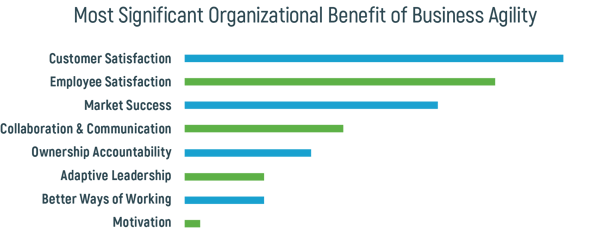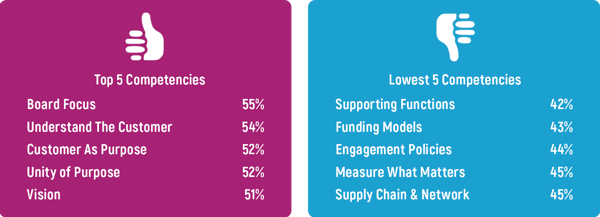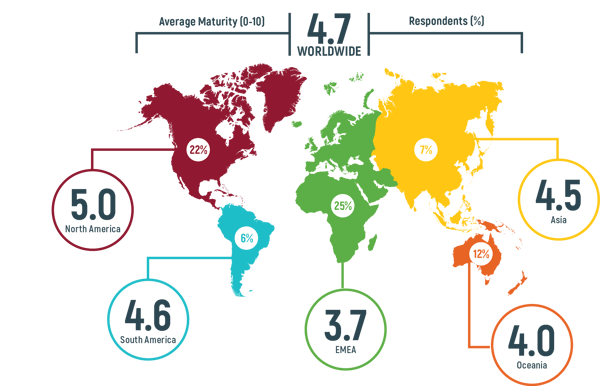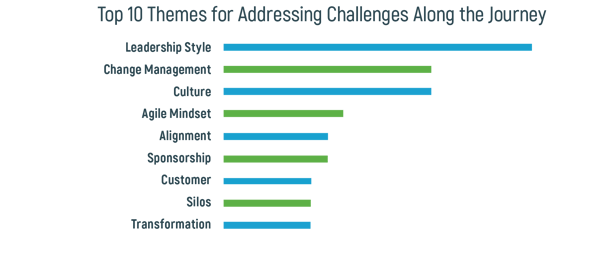The Business Agility Report 2019
We live in a world in which change, complexity, technologies and digitalisation have an ever increasing influence. Many organisations are still stuck in 20th century bureaucratic structures. Especially now in the Corona crisis, it is clear that those who are already agile and have the customer in focus have a clear advantage.
The current "Business Agility Report" asked around 450 people from 274 organizations to identify the opportunities and challenges in agile transformation. In this blog post, we look at the key findings and put them in relation to the current crisis situation.
Advantages of an agile organization:
Most organizations rate the maturity level of their agility as relatively low, but are nevertheless very enthusiastic about the future. The data show significant advantages of agile organizations in terms of:
- Improved customer relationships
- Greater transparency and higher motivation of employees
- Increased sales, market share, brand perception
- Faster turnaround times and better quality of offers

Figure 1: Advantages of an agile organization (Business Agility Report, 2019)
So the advantages of an agile organization seem obvious. But, how does a company become agile? It is interesting to note in this context that companies that were able to demonstrate greater agility always had a special focus on these three key indicators:
Predictive indicators
- Financing models
Adaptive financing models of business results enable companies to quickly and easily invest in new products or services when an opportunity arises in the market. Just as quickly, businesses that do not have the desired business value can be divested or changed.
In times of Corona and beyond, this is likely to become even more important.
- Value Chains
With flexible and customer-oriented value chains, organizations can deploy teams throughout the organization and thus generate added value for the customer.
The pandemic also makes this clear: Companies that are able to quickly address new needs (from respiratory masks to ventilators) are more likely to be able to adapt to the insanely fast changing needs.
- Continuous improvement
A corporate culture that allows continuous learning and trial and error enables organizations to improve continuously. In the long term, this can reduce costs and increase efficiency.
Company size
The size of the company also has an influence on agility. According to the study, small companies are 17% more agile compared to larger ones.
Industries
The most agile companies are active in consulting, followed by retail, hospitality and entertainment. Agile organizations can also be found in information technology.
Factors for a successful implementation of agile transformation
Figure 2: Business Agility Characteristics (Business Agility Report, 2019)
Main factors for a successful agile transformation in a company are the focus of the management, customer understanding and the purpose of the company. Supporting measures, models, order guidelines, supply chains or networks play a lesser role during this process.
Geographic location
The global maturity level is rated at 4.7 on a scale of 0-10. The EMEA region comes last in the region with a score of 3.7. However, it must be noted that the EMEA region is probably the most heterogeneous compared to the other regions.

Figure 3: Agile organizations worldwide (Business Agility Report, 2019)
Drivers of corporate agility
Within the workforce, it can be seen that the role model function of the C-Level, i.e. the first management level and the board, is particularly important in a company for successful implementation and drives the agile transformation forward.
 Figure 4: Who is driving the transformation (Business Agility Report, 2019)
Figure 4: Who is driving the transformation (Business Agility Report, 2019)
Challenges for the implementation of an agile transformation
As challenges for the implementation of an agile transformation, the leadership style, change management, corporate culture and the agile mindset of a company are crucial.
 Figure 5: Challenges of agile transformation (Business Agility Report, 2019)
Figure 5: Challenges of agile transformation (Business Agility Report, 2019)
Management style
The management style has by far the greatest influence. Experience shows that the management level sets the tone for the entire organisation. If the transformation is insufficiently supported, the change in the company stagnates.
Even if some of the managers do not accept the new corporate culture, unclear communication has negative effects on the entire organization. Managers should therefore be aware of how to implement the agile mindset and how to handle change management, because their behavior will transfer to the employees and the entire company.
Change Management
Companies often see the first positive results of agile transformation, but fall back into old patterns and structures after a short time. Often there is a misalignment or a lack of clarity about vision and goals. Communication is often neither transparent nor up-to-date. If employees are not actively involved in the transformation process, the transformation is not accepted and failure is pre-programmed. One way of counteracting such a development is to develop transformation support into a core competence for the entire workforce rather than a skill that only selected specialists can provide. Promoters can be trained regularly and drive the transformation process positively at all levels.
Corporate Culture
Corporate culture is another challenge in the agile transformation process, especially in the scaling and growth process. Experience shows that it usually takes many years before a new corporate culture is established.
Every company unconsciously has mechanisms that are set in motion in certain situations, e.g. when the market changes or customer behavior changes. These mechanisms have been established in the company over decades.
The current Corona pandemic now offers - as absurd as it may sound - the unique opportunity to question typical patterns of action, because very few companies can simply carry on as before. Most of them are challenged to the core and many have been hit to the core.
It should be clear to all those involved in the company that a cultural change is a lengthy process. The management level should consistently make sure that conscious steps are taken with the new culture, communicate consistently, offer support and be open to questions.
Agile Mindset
The agile mindset summarizes the main principles, values and practices of a company and forms one of the cornerstones of its corporate culture. Due to workload or market changes, it is easy to fall into an outdated management style.
Managers should therefore increasingly hand over decisions to the team and support them, even if they would make a different decision themselves. Furthermore, managers should create an environment in which wrong decisions can be made so that the team can try new things without fear.
In order to strengthen the agile mindset in the organization, it is recommended to offer coaching at all levels throughout the organization and to introduce a mentoring system.
Alignment
One of the main causes of difficulties in implementation is the lack of alignment with the vision and goals of agile transformation. If the alignment is missing, the different areas of the organization start to interpret the strategy themselves. Of course, the overall goal of the organization and the long-term alignment cannot be achieved in this way.
In order to steer against this, it is advisable to actively involve the rest of the workforce in the vision and goals of the company, in addition to the management level and middle management.
Conclusion:
Especially in the current situation, it is becoming apparent that the more agile the organisation is, the greater the satisfaction of customers and employees, the greater the market success and ultimately the healthier the entire organisation is in the long term.
There are numerous challenges in the agile transformation process. The most important thing is to communicate transparently and to involve employees at all levels in the process. Managers have a crucial role model function and coaching and mentoring programs should be used to support the process so that the agile transformation process becomes firmly rooted in the corporate culture and the agile mindset.
Please feel free to contact if we can support you in this process. Due to the current situation we also offer corresponding virtual workshops and coaching. We are looking forward to your request!

